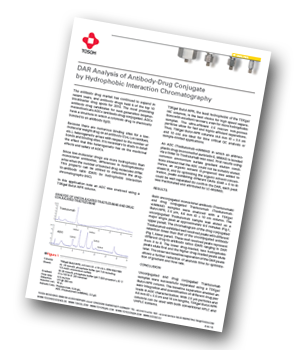Tosoh Bioscience has produced an application note describing drug-to-antibody ratio (DAR) analysis of an antibody-drug conjugate by hydrophobic interaction chromatography (HIC).
 Introduction
Introduction
The antibody drug market has continued to expand in recent years, and antibody drugs held 6 of the top 10 blockbuster drug spots for 2015. The most promising antibody drug candidates for next-generation biopharmaceuticals are ADCs (antibody-drug conjugates). ADCs have a structure in which a cytotoxic drug is chemically bonded to an antibody (IgG).
Because there are numerous binding sites for a low-molecular weight drug on an antibody (Cys, Lys residues, etc.), heterogeneity arises with respect to the number of bonds and binding sites. It is necessary to study in detail the effect that this heterogeneity has on the medicinal effects and safety of ADCs.
Since low-molecular drugs are more hydrophobic than monoclonal antibodies, differences in hydrophobicity arise when the number of bonded drug molecules differ. This property can be utilized to determine the DAR by HIC. In this application note an ADC was analysed using a TSKgel Butyl-NPR column.
Why use theTSKgel Butyl-NPR column?
TSKgel Butyl-NPR, the least hydrophobic of the TSKgel HIC columns, is the best choice for high speed separations with excellent recovery, even for more hydrophobic samples. The ultra-efficient 2.5 micron non-porous particles allow for fast and highly efficient separations. Thus, TSKgel Butyl-NPR columns (4.6 mm ID × 3.5 cm and 10 cm) are ideal for time critical QC analysis or sample-limited applications.
Results
Both unconjugated monoclonal antibody (Trastuzumab) and drug conjugated Trastuzumab (Trastuzumab-vcMMAE) samples were analysed with a TSKgel Butyl-NPR, 2.5 μm, 4.6 mm ID × 10 cm column. The unconjugated Trastuzumab sample was eluted as a major single peak at approximately 9.5 minutes. The chromatogram of the drug conjugated Trastuzumab exhibited well resolved peaks with different retention times than that of the unconjugated antibody. These well resolved peaks represent different DAR ranging from 0 to 8. The lower drug-loaded, less hydrophobic peaks elute first and the higher drug-loaded peaks elute later. The observed baseline separation of the DAR peaks allows a further reduction of analysis time by optimization of gradient and flow-rate.
Conclusion
Unconjugated and drug conjugated Trastuzumab samples were successfully separated using a TSKgel Butyl-NPR column. The baseline separation enabled an easy integration and quantification of different drug pay loads in ADC characterization. With 2.5 μm particles and 4.6 mm ID × 3.5 cm and 10 cm lengths, TSKgel Butyl-NPR columns can be used with both conventional HPLC and UHPLC systems.




